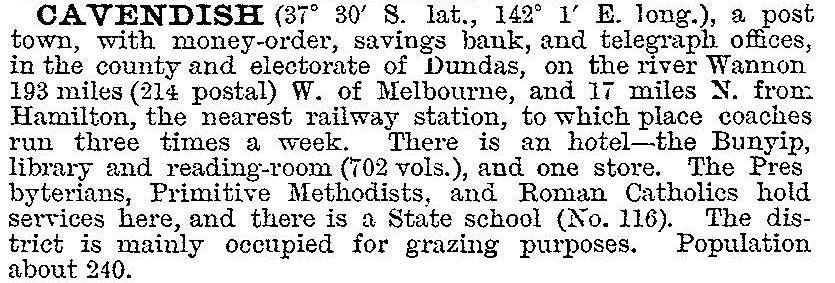Cavendish
The village of Cavendish is located on the Henty Highway 27 km north of Hamilton in the shire of Southern Grampians. It originated in the 1840s at the site of a ford over the Wannon River, and owes much of its early importance to this factor. There are twentieth-century Anglican, Catholic and Lutheran churches built on the opposite – north – side of the river from the Presbyterian church (1858), hotel, stores and police station. The latter still hosts its traditional, nineteenth century bluestone lockup. Cavendish is the family name of the Dukes of Devonshire, one of whom was a contemporary secretary to the British treasury.
Further north towards Balmoral on the Henty Highway is the Glen Isla homestead, an 1875 sandstone structure built around a courtyard, some of the flags of which – originating in the Grampians ranges to the west – contained dinosaur footprints. The homestead is on the State Register of historic buildings.
Cavendish was described in the 1903 Australian handbook:

Cavendish once boasted a sawmill handling timber from the nearby Grampians ranges and the Wannon River valley, but the breakup of nearby sheep runs - Kenilworth and Moorala - under the closer settlement act during 1909 was more significant and created an increased patronage of the village hotel and store. They provided service closer than Hamilton, although a twice weekly Cobb & Co coach service was established to the latter town in the 1850s. Pressure for better rail services in the western district led to the funding of a railway line between Hamilton and Horsham, and this reached Cavendish in 1915.
Evidenced by a substantial memorial hall, soldier settlement developments after both World War I and World War II boosted the local population and briefly improved the village economy. In 1970 the village water supply was integrated with the Hamilton Water Board system. But the amalgamation of many uneconomic agricultural smallholdings and the rise of the motor car to provide easy access to Hamilton's supermarkets and services posed a considerable competition to what Cavendish had to offer the local community. The village has four churches, a memorial hall, the Banyip Hotel, a general store, a recreation reserve and a school (32 pupils in 2014). The hotel is run as a community-owned cooperative, providing useful work experience.
An abandoned composite timber and steel railway bridge across the Wannon River and the site of the station are relics of the Horsham-Hamilton railway line which closed in 1975. Daily bus services to Hamilton are available.
Cavendish's census populations were:
| census date | population |
|---|---|
| 1861 | 118 |
| 1881 | 223 |
| 1901 | 179 |
| 1911 | 438 |
| 1947 | 324 |
| 1966 | 190 |
| 2006* | 454 |
| 2011 | 374 |
*and environs
Further Reading
Diedre J. Payne, Roll call, a history of Cavendish Primary School No 116, 1852-1988, the school, 1990
Dorothy Hoffman (ed), Cavendish souvenir, 1973, back to Cavendish Committee, 1973
Dundas Shire centenary: 1863-1963, Hamilton, 1963


